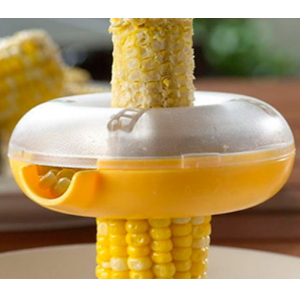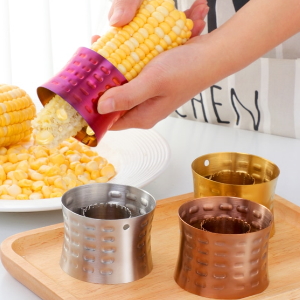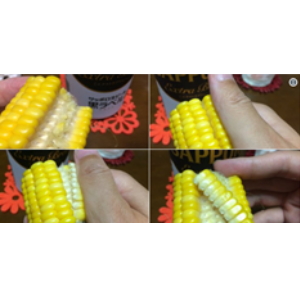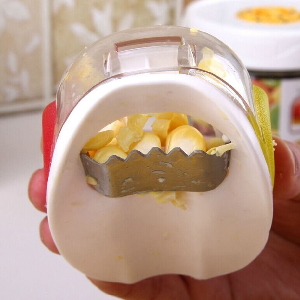How to clean corn from grains at home: the best life hacks for quick processing of a vegetable
Many people like corn: children and adults, adherents of a healthy lifestyle, lovers of high-calorie cereals and mixed side dishes, cereals and sticks, non-standard PP-baked goods made from various flours. Healthy cereals are deservedly stored in the closets and refrigerators of most housewives.
Corn is usually bought canned or frozen for fear of laborious separation of the kernels from the cob core. Consider how easy it is to peel corn kernels at home.
The content of the article
Cleaning corn in different forms
The basic principle of peeling corn does not depend on which ear is used: raw for long-term storage or pre-boiled for consumption in the near future.
In both cases, it is required to extract the grains that sit tightly on the cob.
Boiled

Boiled corn - a tasty, satisfying and healthy independent dish, which is distinguished by the softness of the grains and the relative ease of their separation.
However, it is precisely in this softness that the main difficulty of cleaning lies: with too hard exposure, the grains simply break, and instead of a crumbly dish, although a tasty, but mushy mass is obtained.
For quick and high-quality cleaning, boiled corn is recommended:
- pre-cut across into several small pieces;
- with the blunt side of the knife, separate one row of grains;
- separate the next rows by gently pressing on their bases with your fingers or the blunt side of a knife.
Raw
Raw corn much tougher than boiled. Her grains sit very tightly to each other, so much more effort is required to separate them.
The principle of manual cleaning is in many ways similar to the previous one: it is enough to carefully remove one longitudinal row, and all the others will be removed much easier.
It is interesting:
How to freeze corn on the cob at home
Sweet corn: choosing the best variety and growing it right
Where and how to store boiled corn correctly: different ways
Methods for separating grains from the cob
The most common methods for quick cleaning of corn involve the use of additional manual or mechanical tools. Therefore, many of them are focused exclusively on working with raw, tougher corn.
Some methods are applied to boiled cereals; the main thing is to reduce the force of mechanical impact.
Manual Corn Shelter
A popular and low-cost way to quickly clean the ears is to use a handheld peeler. This device looks like a donut, along the hole of which there are small (up to 8 mm in height) sharp blades.
Step-by-step actions for cleaning corn using such a peeler:

- Pre-cut the top and base of the cob by 1-2 cm, making it even and stable.
- Place the ear in a vertical position and place the plow on the upper cut part.
- Using both hands, lower the device evenly down to the very base, pressing on it with force.
- Collect the grains, remove the stump and clean the plow for next use.
The principle of operation of semi-automatic and automatic cultivators is to use a special cultivating disc with small round teeth, which help to separate the grain from the cob.
The disc rotates either by quickly scrolling a special knob (in semi-automatic devices), or by means of an electric motor.
Important! Semi-automatic and automatic peeling machines are advisable to buy if you need to process large volumes of corn - from several buckets.
Using a drill
Such an unusual method of cleaning cereals requires not only a drill and self-tapping screws, but also strength, ingenuity and dexterity.
They clean corn with a drill like this:
- Pick up a piece of plastic pipe 30–40 cm long with a diameter 3–5 times the diameter of standard ears.
- At a distance of 5–7 cm from the upper edge of the pipe, 7–8 equidistant points are marked, into which screws with a drill are screwed. In this case, the length of each self-tapping screw should be about 1/3 of the diagonal of the pipe, that is, the empty cob should easily, but not too freely, pass into the hole formed by the ends of the screws inside the pipe.
- The prepared pipe is placed with its lower end in a container for collecting grains (for example, a bucket or a high basin), if possible, fixed vertically or gently held during use.
- The longest self-tapping screw is selected, which will hold the cob. His cap is cut off, and the end is inserted into the chuck of an electric drill or screwdriver.
- The next ear of corn is screwed onto a self-tapping screw inserted into a cartridge. They put it with the lower end on self-tapping screws screwed into the pipe, turn on the drill and lower the spinning ear down. The ends of the self-tapping screws quickly and efficiently clean the cereal.
Hand cleaning
Hand-picking is the most straightforward way to clean the cobs, requiring perseverance and strong hands. Raw corn is easier to peel in small, circular rows. The unsuitable upper part of the ear is pre-cut with a sharp knife.
Each subsequent row is removed by strong pressing on it with the lateral surfaces of the thumbs of both hands. If the grains sit too tightly and do not lend themselves to manual removal, they are removed with a knife.
Some craftsmen advise cleaning well-dried ears by rubbing them strongly, which leads to mutual flying of the grains.
With a knife
Another popular cleaning method that requires a little more skill and care is to use a knife... It should be wide enough for a comfortable hand grip, strong and practically unbending.
Most often, they simply cut off the seeds with a knife as close to the stump as possible, which violates their integrity. However, this is quite acceptable if you plan to grind them into flour or use them for cooking cereals.
To obtain even and maximally undamaged grains, it is required to remove the first longitudinal row with the blunt or sharp side of the knife (depending on the hardness of the seeds and the density of their adhesion to each other).
Each successive row is gently squeezed into a suitable container using the blunt side of the knife as a lever.
Life hacks for quickly collecting grains
Pre-cross-cutting of the cob will help speed up the cleaning of the corn.
In this case:

- not the whole grain is processed, but its small parts;
- the cuts made break the high density of the grains adhesion to each other, which greatly simplifies their extraction;
- you can clean a short piece of stump on both sides.
At the same time, there is a high probability of damaging the grains in the places of the cuts, so you will have to carefully divide them into those suitable for long-term storage and those that are best used in the near future.
To clean raw corn takes less time and does not require much effort, it is recommended to pre-dip the prepared ear in boiling water for 2-3 minutes. This will soften the grain and make it easier to remove.

It is allowed to put the cobs in boiling water and leave for 30-40 minutes or until the water cools slightly. In this case, even manual hulling will be several times faster and easier, and with a knife it will be enough to just slightly press on the rows of grains.
Immersion in boiling water or soaking corn in it is permissible only if the extracted grains will be used mainly for conservation or harvesting.If you plan to store them in their usual form, it is better to do with dry cleaning methods or dry the extracted seeds with high quality.
Conclusion
Clearing corn kernels is a simple task if you prepare for it correctly. So, 1-2 ears will turn out to be cleaned by hand, with a knife or with a simple plow. For several dozen cereals, it is better to use a drill or automatic plowing machines, and for serious workpieces, prepare large containers of boiling water in advance and call households for help.
Various cleaning methods allow you to get exactly the product you need: dry and whole - for long storage, slightly damaged and cut - for grinding into flour or making cereals and flakes, scalded and heated - for home preservation.